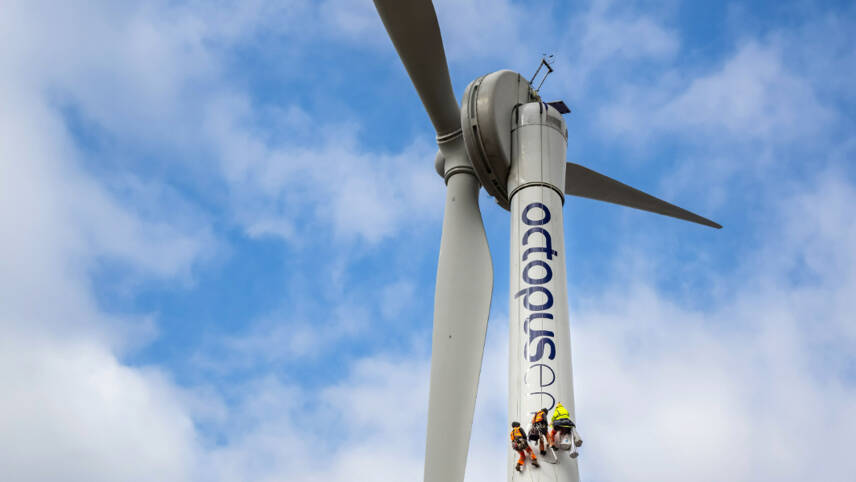Register for free and continue reading
Join our growing army of changemakers and get unlimited access to our premium content

Pictured: One of Octopus' onshore 'Fan Club' turbines
On Monday (1 August), Octopus’s energy generation arm announced a new partnership with wind turbine manufacturer EWT with an aim to repower at least one-tenth of the UK’s older onshore wind turbines. Repowering involves boosting the generation capacity of those turbines which are still online.
The scheme will see turbines upgraded to more powerful models which are better equipped to connect to more modern digital technologies. The first upgrades will begin this autumn and the last should be completed by 2030. Upgrades may involve fitting new blades or replacing whole turbines.
Octopus and EWT have previously worked together to deliver turbines in Caerphilly, Wales, and Market Weighton, Yorkshire. These turbines provide energy to members of Octopus’s ‘Fan Club’, which provides discounted energy to consumers at times of high supply. The two firms will assess whether the communities around the repowered turbines could benefit from a similar approach.
At the publication of the Energy Security Strategy in April, the Government confirmed plans to consult on a new mechanism to entitle communities which support onshore wind in their area to discounted electricity.
This approach could help homes weather the cost-of-living crisis while contributing to the energy transition, it has been acknowledged, but many energy and environment groups have argued that a broader set of supports for onshore wind would have a larger benefit environmentally and economically
New onshore wind installations were effectively banned in England between 2015 and 2021 as they were excluded from the Contracts for Difference (CfD) process. CfD participation is now open, but the Government still allocates most of the auctions to offshore wind. Onshore wind also has no sector deal and no specific expansion targets, unlike its offshore counterpart, to name but two top-line policy barriers. This is without mentioning challenges scaling energy storage for wind in a joined-up way.
The Department for Business, Energy and Industrial Strategy (BEIS) revised its price forecasts for onshore wind in late 2020. It stated that the levelized cost of onshore wind in 2025 would be £46 per MWh, down from the previous forecast of £65 per MWh. Thanks to CfD support, the price fall may well be steeper.
Hornsea One
Also this week, Octopus Energy Generation has invested £200m in the 1.2GW Hornsea One offshore wind farm on behalf of pension scheme Nest. Nest is aiming to funnel up to £250m into European renewables annually, in partnership with Octopus, as part of its plan to halve financed emissions this decade and bring them to net-zero by 2050 at the latest.
Pensions collaboration GLIL Infrastructure, which itself is investing £200m in the world’s largest operational offshore wind farm, has created a joint venture with Octopus and Nest. Together, the organisations are taking a 12.5% stake in the Orsted-led project.
The co-head of Octopus Energy Generation’s fund management team, Alex Brierly, said: “This latest deal is testament to the growing demand we’re seeing from institutional investors to invest in renewable energy. It’s brilliant to be expanding our relationship with Nest and starting a new one with GLIL to help pension savers’ money make a truly positive impact on people and the planet.”
Questions over ethics and governance
While these stories may be good news for the UK’s renewables market and for pension savers looking for ‘greener’ pots, some have questioned the timing of their announcement.
It was reported in several national UK newspapers and on Sky News over the weekend that Octopus is the last remaining bidder for a takeover of failed energy supplier Bulb, and is seeking around £1bn from the Government to do so.
Sky News reported that the deal would involve Octopus paying between £100m and £200m for Bulb, while the Government’s funding would be used to pay off Bulb’s gas debts. The report added that Octopus would intend to pay back the £1bn and to offer the Government a “significant” profit-share agreement.
Bulb entered administration in November 2021, citing the energy price crisis as the final straw, and was placed into ‘special administration’; the Government and Ofgem stepped in to run the firm.
The independent Office for Budget Responsibility said in March that a bailout of Bulb would require more than £2bn to cover its operating losses. In comparison, bailing out the 28 other failed suppliers combined would cost around £2.7-3bn, the OBR estimates.
Several citizens’ groups have argued that asking taxpayers to foot the bill for the Bulb bailout as the cost-of-living-crisis bites would be unfair and unpopular.
The Business, Energy and Industrial Strategy (BEIS) Committee last week published a report assessing the Government’s response to the energy price crisis, concluding that it is not properly preparing homes and businesses for higher bills this winter. That report also highlights a string of failures in regulating the energy supply market before the string of supplier administration filings late last year.


Please login or Register to leave a comment.